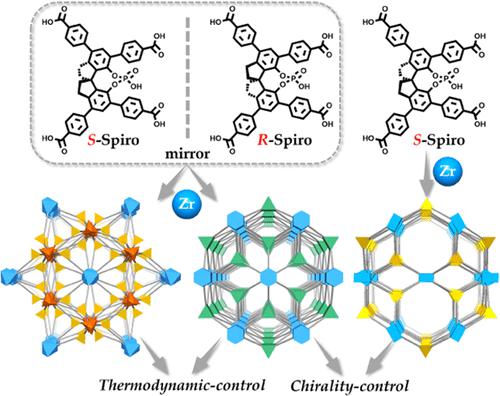当前位置:
X-MOL 学术
›
J. Am. Chem. Soc.
›
论文详情
Our official English website, www.x-mol.net, welcomes your
feedback! (Note: you will need to create a separate account there.)
Reticular Chemistry in Its Chiral Form: Axially Chiral Zr(IV)-Spiro Metal–Organic Framework as a Case Study
Journal of the American Chemical Society ( IF 14.4 ) Pub Date : 2023-06-13 , DOI: 10.1021/jacs.3c03036 Wei Gong 1 , Xinfa Chen 1 , Kira M Fahy 2 , Jinqiao Dong 1 , Yan Liu 1 , Omar K Farha 2, 3 , Yong Cui 1
Journal of the American Chemical Society ( IF 14.4 ) Pub Date : 2023-06-13 , DOI: 10.1021/jacs.3c03036 Wei Gong 1 , Xinfa Chen 1 , Kira M Fahy 2 , Jinqiao Dong 1 , Yan Liu 1 , Omar K Farha 2, 3 , Yong Cui 1
Affiliation

|
The interplay of primary organic ligands and inorganic secondary building units (SBUs) has led to a continual boom of reticular chemistry, particularly metal–organic frameworks (MOFs). Subtle variations of organic ligands can have a significant impact on the ultimate structural topology and consequently, the material’s function. However, the role of ligand chirality in reticular chemistry has rarely been explored. In this work, we report the organic ligand chirality-controlled synthesis of two zirconium-based MOFs (Spiro-1 and Spiro-3) with distinct topological structures as well as a temperature-controlled formation of a kinetically stable phase (Spiro-4) based on the carboxylate-functionalized inherently axially chiral 1,1′-spirobiindane-7,7′-phosphoric acid ligand. Specifically, Spiro-1 is a homochiral framework comprising only enantiopure S-spiro ligands and has a unique 4,8-connected sjt topology with large 3D interconnected cavities, while Spiro-3 contains equal amounts of S- and R-spiro ligands, resulting in a racemic framework of 6,12-connected edge-transitive alb topology with narrow channels. Interestingly, the kinetic product Spiro-4 obtained with racemic spiro ligands is built of both hexa- and nona-nuclear zirconium clusters acting as 9- and 6-connected nodes, respectively, giving rise to a newly discovered azs net. Notably, the preinstalled highly hydrophilic phosphoric acid groups combined with large cavity, high porosity, and outstanding chemical stability endow Spiro-1 with remarkable water vapor sorption performance, whereas Spiro-3 and Spiro-4 show poor performances due to inappropriate pore systems and structural fragility upon the water adsorption/desorption process. This work highlights the important role of ligand chirality in manipulating the framework topology and function and would further enrich the development of reticular chemistry.
中文翻译:

手性形式的网状化学:轴向手性 Zr(IV)-螺环金属有机骨架案例研究
初级有机配体和无机次级结构单元(SBU)的相互作用导致了网状化学的持续繁荣,特别是金属有机框架(MOF)。有机配体的细微变化会对最终的结构拓扑产生重大影响,从而对材料的功能产生重大影响。然而,配体手性在网状化学中的作用很少被探索。在这项工作中,我们报道了两种具有不同拓扑结构的锆基 MOF(Spiro-1 和 Spiro-3)的有机配体手性控制合成以及动力学稳定相(Spiro-4)的温度控制形成基于羧酸酯功能化的固有轴向手性 1,1'-spirobiindane-7,7'-磷酸配体。具体来说,Spiro-1 是仅包含对映体纯的同手性框架S-螺配体,具有独特的 4,8-连接sjt拓扑结构,具有大型 3D 互连空腔,而 Spiro-3 包含等量的S-和R-螺配体,形成 6,12-连接边缘-的外消旋框架具有窄通道的传递alb拓扑。有趣的是,用外消旋螺配体获得的动力学产物Spiro-4由六核和非核锆簇构成,分别作为9连接节点和6连接节点,从而产生了新发现的azs网。值得注意的是,预装的高亲水性磷酸基团与大空腔、高孔隙率和出色的化学稳定性相结合,使Spiro-1具有出色的水蒸气吸附性能,而Spiro-3和Spiro-4由于不合适的孔隙系统和结构而表现出较差的性能。水吸附/解吸过程中的脆性。这项工作强调了配体手性在操纵框架拓扑和功能中的重要作用,并将进一步丰富网状化学的发展。
更新日期:2023-06-13
中文翻译:

手性形式的网状化学:轴向手性 Zr(IV)-螺环金属有机骨架案例研究
初级有机配体和无机次级结构单元(SBU)的相互作用导致了网状化学的持续繁荣,特别是金属有机框架(MOF)。有机配体的细微变化会对最终的结构拓扑产生重大影响,从而对材料的功能产生重大影响。然而,配体手性在网状化学中的作用很少被探索。在这项工作中,我们报道了两种具有不同拓扑结构的锆基 MOF(Spiro-1 和 Spiro-3)的有机配体手性控制合成以及动力学稳定相(Spiro-4)的温度控制形成基于羧酸酯功能化的固有轴向手性 1,1'-spirobiindane-7,7'-磷酸配体。具体来说,Spiro-1 是仅包含对映体纯的同手性框架S-螺配体,具有独特的 4,8-连接sjt拓扑结构,具有大型 3D 互连空腔,而 Spiro-3 包含等量的S-和R-螺配体,形成 6,12-连接边缘-的外消旋框架具有窄通道的传递alb拓扑。有趣的是,用外消旋螺配体获得的动力学产物Spiro-4由六核和非核锆簇构成,分别作为9连接节点和6连接节点,从而产生了新发现的azs网。值得注意的是,预装的高亲水性磷酸基团与大空腔、高孔隙率和出色的化学稳定性相结合,使Spiro-1具有出色的水蒸气吸附性能,而Spiro-3和Spiro-4由于不合适的孔隙系统和结构而表现出较差的性能。水吸附/解吸过程中的脆性。这项工作强调了配体手性在操纵框架拓扑和功能中的重要作用,并将进一步丰富网状化学的发展。




















































 京公网安备 11010802027423号
京公网安备 11010802027423号